Although the HMS Dreadnought inspired an entire generation of battleships, it never saw a naval battle itself during World War I.
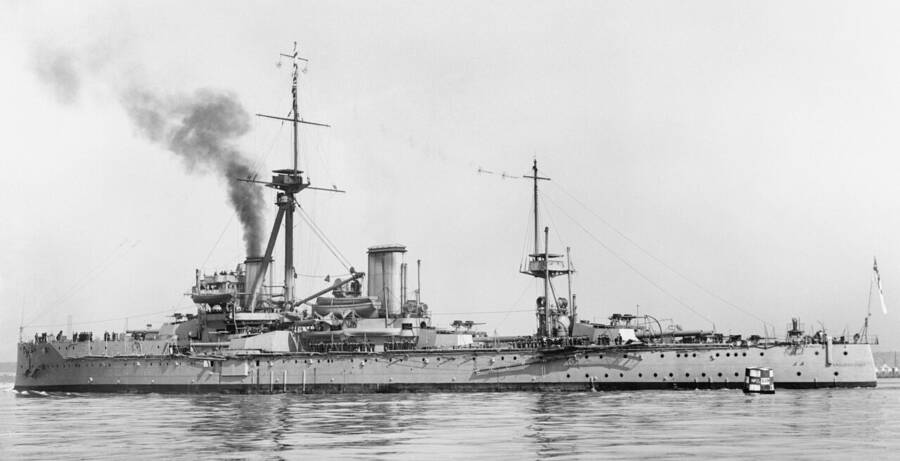
Public DomainThe HMS Dreadnought in 1907, the year after it was launched.
On Feb. 10, 1906, King Edward VII smashed a bottle of champagne against the bow of the British Navy’s newest warship as a crowd of 60,000 watched. But the bottle didn’t break. It took the king multiple tries to finally shatter the glass, which, perhaps, shouldn’t have been surprising. The newly built HMS Dreadnought was unlike any ship that had ever existed.
The Dreadnought was not only equipped with a stunning array of high-powered guns. It could not only outrun any other ship on the planet. It had also been built by the British Navy in roughly 12 months.
World powers across the globe took notice, and the United States, Russia, and France swiftly started building “dreadnoughts” of their own. But the new British warship especially caught the attention of Germany.
The Germans had long desired to become a world power, and they knew that a strong navy was key. Though the Germans had already started to expand their navy at the turn of the 20th century, the introduction of the HMS Dreadnought put this effort into overdrive. Before long, Germany and Great Britain were engaged in a naval arms race.
On the eve of World War I, the two countries began to battle for supremacy at sea.
The Brewing Naval Arms Race Between Great Britain And Germany
At the turn of the 20th century, both Great Britain and Germany wanted to modernize their navies — although for different reasons.
For Germany, it was a matter of being taken seriously as an empire. As a relatively new country — Germany had unified in 1871 — the Germans believed that a strong navy was the key to becoming a global power.
Admiral Alfred von Tirpitz set out to make this dream a reality by building up the German Navy. The Navy Bills of 1898 and 1900 aimed to expand Germany’s network of ships, with the goal of creating a fleet that could stand up to the British. Tirpitz reasoned that if the Imperial German Navy was competitive with the Royal Navy, Great Britain would be more accommodating toward Germany’s ambition to become a world power.
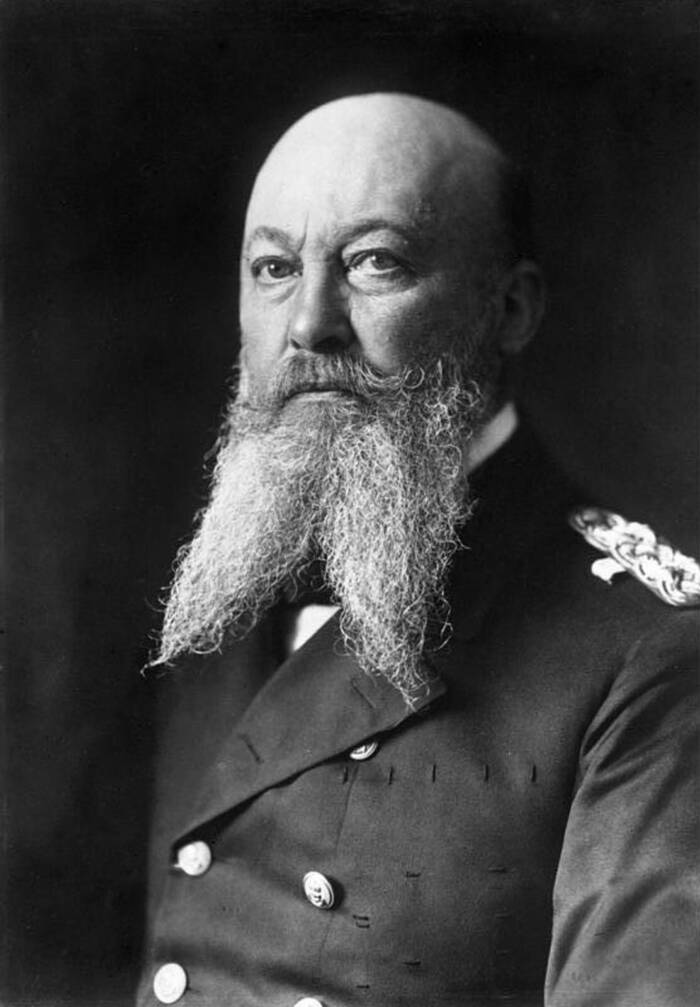
Public DomainAt the turn of the 20th century, German Admiral Alfred von Tirpitz started building up the German Navy in hopes of making Germany into a world power.
The admiral was robustly supported by Kaiser Wilhelm II, the grandson of Queen Victoria, who wrote in his autobiography:
“I had a peculiar passion for the Navy. It sprang to no small extent from my English blood. When I was a little boy… I admired the proud British ships. There awoke in me the will to build ships of my own like these some day, and when I was grown up to possess a fine Navy as the English.”
At the time, the British were in the midst of their own military build-up. Sir John A. Fisher, who was appointed First Sea Lord in 1904, set out to modernize the British fleet at the turn of the 20th century. The Royal Navy had long been the source of national pride, but most of its ships had gotten old. Fisher took 154 warships out of service and began to plot the design of a new ship that would — literally — blow old vessels out of the water.
The ship that Fisher set out to build would become known as the HMS Dreadnought, a name that came from the saying “dread nought but God.”
The Introduction Of The HMS Dreadnought
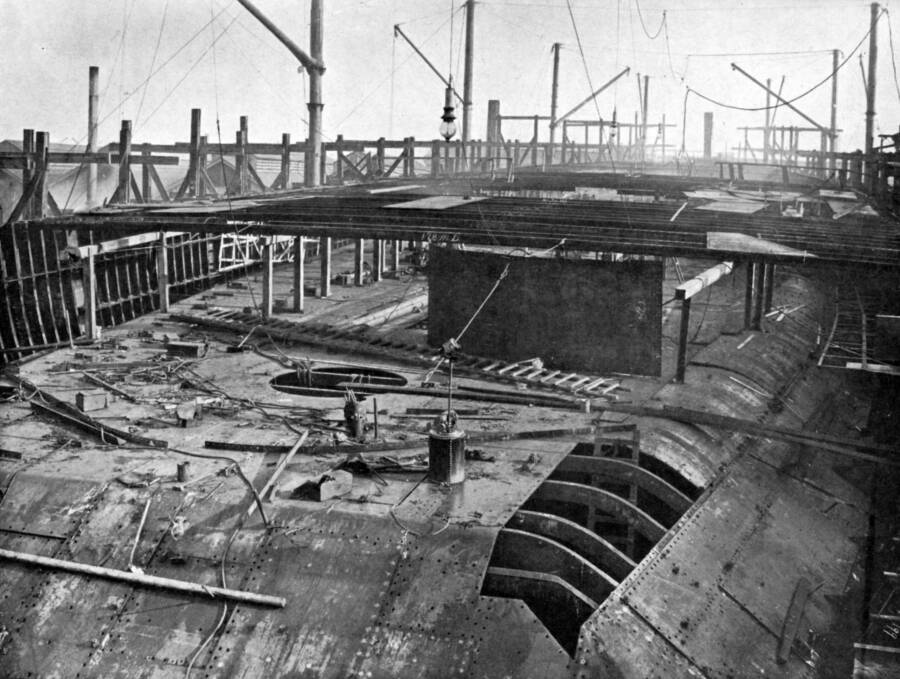
Public DomainThe HMS Dreadnought 36 days into its construction. The ship took about 12 months to build, and there were just 15 months between the start of its construction and its commission into the Royal Navy.
At the time, no ship had been completed in fewer than 31 months. But Fisher wanted the HMS Dreadnought built in just 12 months. Construction started at the Royal Naval Dockyard at Portsmouth on Oct. 2, 1905, and by February 1906, the ship’s hull was finished and ready to be christened.
Though it took King Edward VII several tries to smash a bottle of champagne against the ship’s bow, the crowd of 60,000 watching was ecstatic. And though the HMS Dreadnought would not start its sea trials until that October, the introduction of the new warship sent tremors across the world.
There had never been a ship like the Dreadnought before. The powerful vessel had 10 12-inch guns, which could easily destroy a ship 10 miles away. As if that wasn’t enough, the ship was also equipped with 24 three-inch quick-firing guns, five Maxim machine guns, and four torpedo tubes.
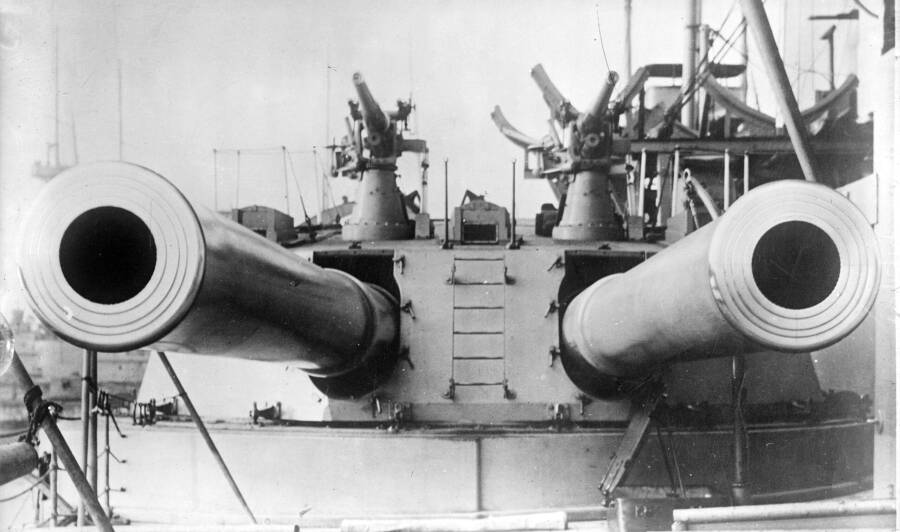
Library of CongressA pair of the HMS Dreadnought’s 12-inch guns.
But the HMS Dreadnought was not only powerful. It was fast. Equipped with new steam turbine engines, the ship could sail at 21 knots, or roughly 25 miles per hour. The modern engines were also far more reliable than those on older ships and could be used for longer stretches of time.
What’s more, the ship was able to join the Royal Navy in December 1906. That meant that it had taken just 15 months from the start of the vessel’s construction to its commission, half the time it took most ships to be built.
It also meant that no other ship in the world could compete. The HMS Dreadnought had made all other navies obsolete. So other countries — especially Germany — started to build “dreadnoughts” of their own.
How The HMS Dreadnought Changed Warfare
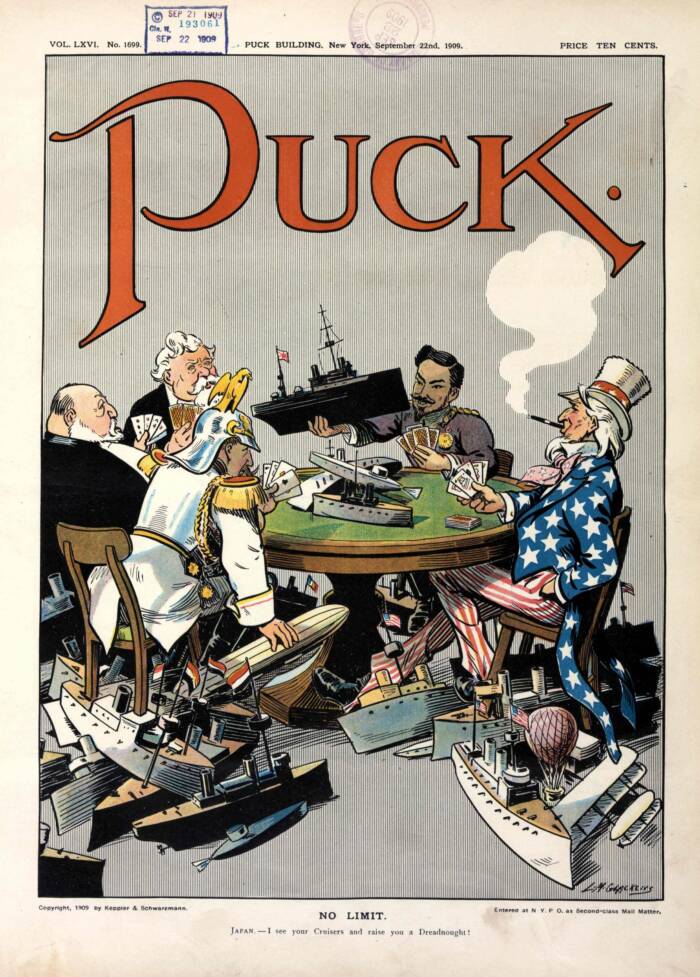
Public DomainA 1909 cover of Puck depicting a worldwide naval arms race.
After the introduction of the HMS Dreadnought in 1906, other world powers started building advanced warships of their own. Japan launched a “semi-dreadnought” called Satsuma in November 1906, Germany debuted its first dreadnought — the SMS Nassau — in 1907, and the United States launched the USS Michigan in 1908.
Italy, Russia, France, and Austria-Hungary quickly followed. But shipbuilding fever was especially prevalent in Germany and Great Britain.
In Germany, Kaiser Wilhelm and Tirpitz set out to match the pace of British shipbuilding with several new dreadnoughts of their own. Meanwhile, the speed at which the Germans were building ships began to panic the British. Great Britain had long followed the “two-power standard” rule, which maintained that the Royal Navy should be at least as large as the next two navies combined.
Germany’s growing navy threatened this balance of power, and the British public began to clamor for more dreadnoughts as tensions between Germany and Great Britain increased. “We want eight and we won’t wait!” was a popular cry at the time, and Winston Churchill, then the Home Secretary, once quipped, “The Admiralty had demanded six ships; the economists offered four; and we finally compromised on eight,” according to the International Churchill Society.

Public DomainThe HMS Dreadnought at sea. More dreadnoughts followed, though they were eventually replaced with even more powerful ships known as super-dreadnoughts.
Ultimately, the world’s first dreadnought was just one factor that led Europe into World War I. But it was a significant one. The development of the HMS Dreadnought in 1906 poured gasoline on the simmering naval arms race between Great Britain and Germany. It increased tensions between the two nations. And it altered the balance of power in Europe.
When World War I broke out in 1914 following the assassination of Franz Ferdinand, Great Britain entered the conflict with 29 dreadnoughts at the ready. Germany had 17.
By then, however, even the dreadnought was obsolete. Countries had began to produce even more powerful ships called “super-dreadnoughts” in 1912.
Ultimately, the HMS Dreadnought, the ship that had started it all, played only a minor role in World War I. Though it sank a German U-boat, the world-changing ship did not participate in any major battles. By 1914, there were far more fearsome vessels patrolling the high seas.
After reading about the HMS Dreadnought and how it changed naval warfare, look through these harrowing photos of World War I trenches. Or, discover the story of the Paris Gun, or the Kaiser Wilhelm Gun, which is considered the largest gun used during the conflict.





